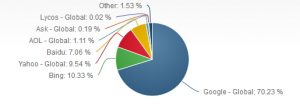
Imagine, for a moment, that your company’s website is not a website at all, but a restaurant. Chez Website. In terms of quality, your restaurant endeavor is going swimmingly; you have consistent meals, interesting décor, and fantastic wait staff. Unfortunately though, your profits are just not where you need them to be in order to stay viable. But alas! Good news is on the way! A hospital is opening up just down the block from you so foot traffic and dinner rushes are going to be getting a huge boost in volume! This will be huge for revenue and means that you can start to let the quality and service slack a little bit, right?
Wrong (obviously)!
Increased traffic is great, but it will be rendered meaningless if you don’t capitalize on it by maintaining the quality of the product. The first meals of all those new visitors will be a nice boost, but if they’re not satisfied enough to return – or promote your restaurant to their friends and families – then you’ve missed your opportunity to increase revenue on a more permanent basis.
Now think about your actual website. What metrics do you use to gauge performance? As with the restaurant example, getting too bogged down in things like traffic – vanity metrics – will give you an incomplete and often delusional understanding of your site’s performance. Vanity metrics are numbers that give information about website performance, but not information that reflects actual usefulness or increased profitability.
“The reason traffic in and of itself isn’t a sufficient measurement of performance is that traffic does not correlate directly with profit. Your website’s functionality is based not just on being seen, but being engaged with.
A way to avoid this pratfall is to instead focus on actionable metrics. Actionable metrics are those which give you useful information on your site’s performance up to that point, and direct your actions moving forward. By using actionable metrics, you’ll guide your strategies towards complete optimization and increased profits.
An example of an actionable metric would be something like lead conversion. Every time a lead interacts with your website is an opportunity. If your opportunities are going by the wayside because conversion rates are low, no amount of traffic in the world can drag your revenues back up. Converting those leads into customers is the whole reason you spent the time to create a website in the first place, so why let your focus get derailed by wondering whether they simply arrived at the site; that’s relatively meaningless and you and your site can do better!
Once you have established some data about the rate with which you are converting leads into customers, your task becomes acquiring data on how you are nurturing them as customers. If you are successful with this stage in the buyer’s journey, you should be able to see in measurable results that your customers are returning to buy your products and engage with your brand on a repeated basis. If your customers are satisfied with their experience enough to come back for more, then you know that your product provides adequate value and (equally important) that your website is functioning properly.
Now that we know which metrics are best to be looking out for, what are the best ways to organize and analyze them? Luckily, a lot of the grunt work in this area can be done automatically, with software designed for this specific purpose. Programs through Hubspot, Optimizely, Unbounce, and free tools like SumoMe are great for this purpose. Through SumoMe’s Content Analytics and Heat Maps tools, we’re able to see the percentage of the page that was read, as well as number of clicks and where users clicked without even leaving a blog post. Below you can see that out of 83 clicks on a blog post about Instagram, the majority were to download a free ebook.

Similarly, in HubSpot you can track exactly how your site’s visitors engaged with the content contained therein. You can see not just how many people viewed a particular blog post, but exactly how many clicked on the Call-to-Action. Also, you can see where referrals and references have been made on social media, what platforms they were displayed on, and by whom. The level of specificity is key here. These defining categorizations take the information on the blog post from vanity to actionable, and the interpretation of that “actionable” data doesn’t require any further work from you; it’s done through the software so all you have to do is keep making clear decisions.
Optimizely, too, has successfully positioned itself as a maverick in the world of actionable data:
“Say goodbye to technical bottlenecks and hello to actionable data. Optimziely acts as your on-demand technical team, with technology that turns your creative changes into instantly generated and deployed code.”
Keeping in line with this expressed mission, the software enables you to bypass the timely process of code-writing and number crunching. Instead, you are left with a trove of organized and actionable data with which to base your design decisions and marketing strategies.

Unbounce also provides templates for data integration, but they don’t stop there. Unbounce is a great resource for everything from A/B testing formats to landing page creation. They tie it all together with real-time statistics that aren’t limited to visitation tallying. The stats provided also include conversions, conversion rate, and even statistical confidence – which is a measure of how likely the results are to be based on reasons other than chance alone. As you can see, software tools like these are a great way to funnel the statistics about how your website is performing into actionable categories, leading to a far more optimized website and a better experience for your customers when they visit it.
Recap
Getting as many people as possible to view your website is important, and it always will be. I certainly won’t argue that. What I would say, though, is that it these types of statistics based solely on traffic – and not on what you and your website are able to do with that traffic – are a dangerously easy to get caught up on. They won’t give you easily identifiable paths of action to improve your site, and they won’t let you know what specific pain points aren’t being addressed for your consumers. However, you use them as a building foundation for more detailed and actionable metrics to be placed on top of, you’ll be able to see more clearly how your website has performed thus far, and how you can improve it moving forward.
(244)









